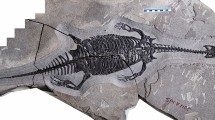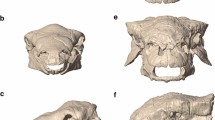Abstract
Our analysis showed that the cranial strength of Allosaurus far exceeded the stresses that could have been generated by its jaw-closing muscles, and we suggested that this disparity might be explained if this dinosaur had adopted a 'slash-and-tear' mode of attack. Frazzetta and Kardong raise three points in criticism of this suggested mode of feeding.
Similar content being viewed by others
Rayfield et al. reply
First, they point out that no living tetrapod (lizard) attacks prey in quite this way. However, there are no living equivalents of the 1–2-tonne, bipedal, very large-headed predators. Given that Allosaurus was the top predator in the Late Jurassic period1 and its prey included a range of large, herbivorous dinosaurs (ornithopods, stegosaurs and sauropods), its feeding strategies may not have conformed to those of small, modern lizards or even the largest of snakes.
Concerning the tooth and jaw morphology of Allosaurus, the upper teeth show significant size variation as they emerge in a staggered tooth-eruption sequence, presenting a discontinuous, coarse profile. This arrangement is ideally suited to creating a deep, lacerating wound. Furthermore, the upper tooth row is longer than the lower and contains more teeth, whereas the lower jaw is relatively slender and tapers towards its tip. These features of the lower jaw are concordant with our interpretation that the upper jaw is the primary weapon of attack.
Assuming that subsequent dismemberment of prey requires lower-jaw dentition, on what basis should the teeth be multi-regional in Allosaurus? Strong 'regionalization' of teeth is a trademark of heterodont synapsids. Also, contrary to the claims of Frazzetta and Kardong, there are significant differences between many theropods in terms of tooth shape, head shape and body size2,3. Allosaurus is the only taxon to which FEA has been applied, so it is not currently possible to compare feeding strategies among theropods.
Frazzetta and Kardong argue that cranial flexibility (kinesis) requires a transverse hinge across the top or back of the skull. The skull roof and back of the skull of Allosaurus fragilis are not hinged transversely and there is a complete lower temporal bar. The authors note that the basal articulation is flexible and imply that it was involved in fore–aft intracranial sliding, as seen in kinetic lizard skulls. In fact, the basal articulation is not capable of sliding in this sense, but allows the palate to rotate safely against the braincase when the skull is subjected to vertical bending forces4.
Furthermore, intracranial displacement between the palatal bones and the cheek region reduces stress at the basal articulation during an impact bite4, so 'basal robusticity' at this joint is not required. The conditions required for pro-; meso- or metakinesis are not met in the allosaur skull, and modern lizards and snakes cannot be considered as an appropriate analogue.
Frazzetta and Kardong's comments on our analysis erroneously apply lepidosaur cranial mechanisms to theropod dinosaur skulls. A vertically deep, narrow-headed predator would find its head structurally compromised by high torque when wrestling with large prey5. As we pointed out, shear stresses are insignificant and fenestrae strengthen, rather than weaken, the skull when it is subjected to large vertical forces. Recent analysis4 shows the lower jaw to be substantially weaker than the upper jaw. 'Slash-and-tear' feeding rather than 'predator–prey struggling' best explains this disparity.
Although our attack strategy was proposed cautiously as an interpretation in the light of the original FEA analysis, we find no evidence here to make us radically revise our initial suggestion.
References
Dodson, P., Behrensmeyer, A. K., Baker, R. T. & McIntosh, J. S. Paleobiology 6, 208–232 (1980).
Farlow, J. O., Brinkman, D. L., Abler, W. L. & Currie, P. J. Mod. Geol. 16, 161–198 (1991).
Abler, W. L. Paleobiology 18, 161–183 (1992).
Rayfield, E. J. Cranial Form and Function in a Large theropod Dinosaur: A Study Using Finite Element Analysis. Thesis, Univ. Cambridge (2001).
Busbey, A. B. in Functional Morphology in Vertebrate Paleontology (ed. Thomason, J. J.) 173–192 (Cambridge Univ. Press, 1995).
Author information
Authors and Affiliations
Corresponding author
Rights and permissions
About this article
Cite this article
Rayfield, E., Norman, D. & Upchurch, P. Prey attack by a large theropod dinosaur. Nature 416, 388 (2002). https://doi.org/10.1038/416388a
Issue Date:
DOI: https://doi.org/10.1038/416388a
Comments
By submitting a comment you agree to abide by our Terms and Community Guidelines. If you find something abusive or that does not comply with our terms or guidelines please flag it as inappropriate.



